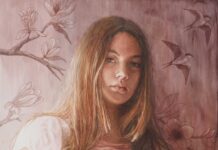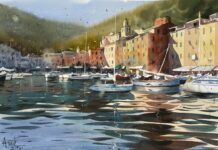
I’m on the road about half the year. No matter where I go or the reason for the trip, I always take everything I need to paint outdoors. In fact, my plein air gear is always the first thing I pack, because if I don’t get to paint for maybe two days, I get really cranky.
For landscape painters in particular, it’s the best way to capture life. Working from a photo may be easier, but the subject doesn’t move. Outdoors, the subject and the light are constantly changing. It’s challenging, but the experience is so important for learning how to observe and understand. I sometimes see students pull out their reference photo at the start of class and right away begin copying, without really thinking.
Also, you develop a sense of urgency. Because everything changes so quickly, you have to keep going, otherwise you’re lost. That’s good training, I think. You have to make the best decision possible, as quickly as possible, so that you can stay in the moment.
I know every painter is different, but if I worked from photos, I would think, “Well, I can paint anytime.” I would stop and have a cup of coffee. I would just be lazy. When I’m outside, working with a time limit, it keeps me focused.
Focusing on Big Shapes and Contrasts
Follow along as I paint La Paloma Theatre, a historic Spanish Colonial Revival-style movie theater en plein air in Encinitas, California.

Step 1
To start, I sketch out the scene on my watercolor paper. I try to identify the bigger shapes first, then the smaller ones, but I don’t feel the need to draw everything I see. For example, I don’t see anything here in the trees that I need to add. Anything that has a contrast, however, I draw, because I have to be careful of the light and dark areas, and make sure I get those right. If two adjoining objects don’t have much contrast, I don’t feel the need to draw them.

Step 2
Before I apply my first wash, the first thing I have to think about is where to save my whites, because I don’t use masking fluid. Those are the only areas I have to be careful about; otherwise I just put in color. I don’t necessarily wet the paper first, but I work quickly, so I start using a different color before first one is dry.

Step 3
I start adding my dark values and connecting them. In the first wash, I use many colors, but once I start applying my darks, I don’t change colors too much. My darks are all mixed; they’re never a single color. I think about color temperature — is this area warm or is it cool? — without altering the color very much.

Step 4
At this stage, I start to focus on the small details. I keep adding darks, and trying to make connections. I forget about reality at this point. I don’t look at my subject anymore; I just look at my painting. I think about what’s missing or what needs to be corrected.

Join Keiko Tanabe and other world-class painters to learn more about the joys and rewards of plein air painting at Plein Air Live!







